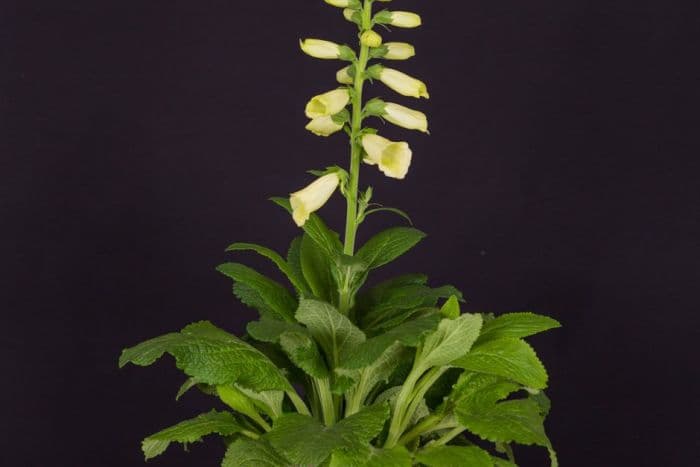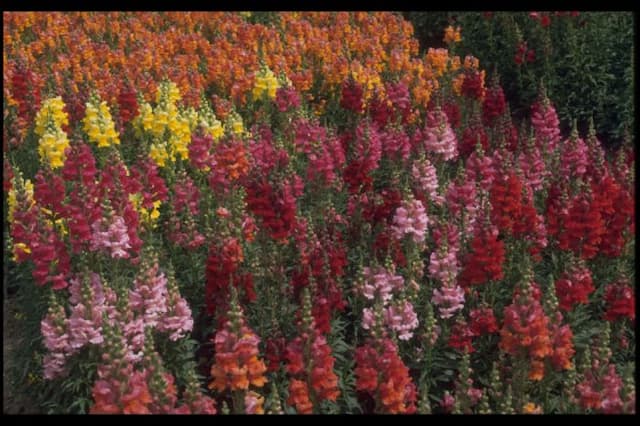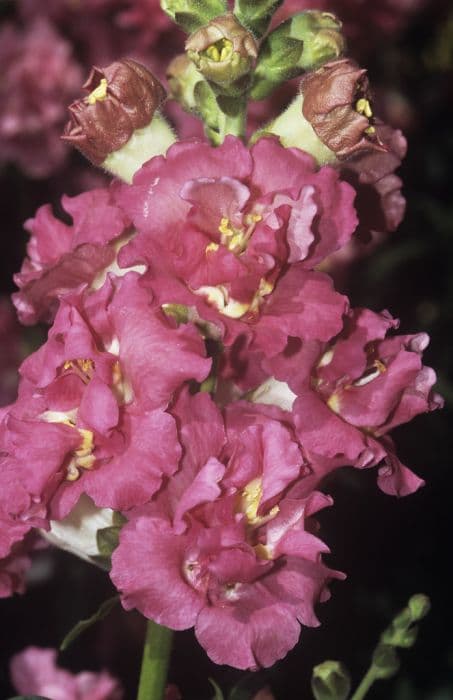Foxglove Digitalis 'Lemoncello'

ABOUT
Digitalis 'Lemoncello' is commonly known as the Foxglove 'Lemoncello'. This plant stands out with its unique, bell-shaped flowers neatly arranged in spikes, displaying a delightful shade of yellow. Each flower blooms with a subtle gradient of lemony hues, adding a touch of whimsy to gardens. The petals possess a delicate texture, sometimes with minor speckling inside the bell, which adds depth and character to the overall appearance. The foliage of the Foxglove 'Lemoncello' is also notable, consisting of large, lance-shaped, dark green leaves that form a lush base for the towering flower spikes. The arrangement of the flowers on the stem is dense and provides a continuous display of color throughout its blooming period. The plant's overall presentation is one of classic elegance and fairy-tale charm, which makes it a favorite for cottage-style gardens and borders.
About this plant
 Names
NamesFamily
Plantaginaceae
Synonyms
Foxglove, Lady's Glove
Common names
Digitalis 'Lemoncello'
 Toxicity
ToxicityTo humans
Foxglove, including the cultivar 'Lemoncello', is highly toxic to humans if ingested. It contains cardiac glycosides which can cause severe symptoms including nausea, vomiting, diarrhea, headache, stomach pain, dizziness, changes in vision, and confusion. Ingesting parts of the plant, especially the leaves, can lead to potentially fatal disruptions in heart function, including arrhythmias, bradycardia, or tachycardia. Immediate medical attention should be sought if ingestion is suspected.
To pets
Foxglove is also poisonous to pets such as dogs and cats. As with humans, the ingestion of any part of the plant can lead to cardiac glycoside toxicity. Symptoms of poisoning in pets may include drooling, nausea, vomiting, diarrhea, weakness, cardiac arrhythmias, and even seizures. Depending on the amount ingested, this can result in fatal heart failure. Urgent veterinary care is essential if a pet is suspected to have ingested foxglove.
 Characteristics
CharacteristicsLife cycle
Biennials
Foliage type
Deciduous
Color of leaves
Green
Flower color
Yellow
Height
2-3 feet (60-90 cm)
Spread
1-2 feet (30-60 cm)
Plant type
Herb
Hardiness zones
4
Native area
Europe
Benefits
 General Benefits
General Benefits- Attracts pollinators – Digitalis 'Lemoncello' is known to attract bees and other pollinators, which is beneficial for the overall health of your garden.
- Visual appeal – With its striking yellow flowers, this Foxglove variety adds a splash of color to any garden or landscape.
- Vertical interest – The tall spikes of Digitalis 'Lemoncello' provide vertical interest, which can add structure and depth to garden beds.
- Cottage garden charm – Foxgloves are classic cottage garden plants, and Digitalis 'Lemoncello' helps create a traditional, romantic garden aesthetic.
- Shade tolerance – This plant can tolerate partial shade, making it a versatile choice for different garden situations.
- Deer resistance – Deer tend to avoid Digitalis, making 'Lemoncello' a good option for areas with deer pressure.
- Easy to grow – With proper conditions, Digitalis 'Lemoncello' is easy to cultivate, making it suitable for gardeners of all skill levels.
- Biennial lifecycle – As a biennial, Digitalis 'Lemoncello' offers two years of growth, providing foliage the first year and flowers the second year.
- Companion planting – It pairs well with other shade-loving perennials, enhancing overall garden design.
- Cut flowers – The blooms of Digitalis 'Lemoncello' make excellent cut flowers for indoor arrangements.
 Medical Properties
Medical Properties- This plant is not used for medical purposes.
 Air-purifying Qualities
Air-purifying QualitiesThis plant is not specifically known for air purifying qualities.
 Other Uses
Other Uses- Foxglove 'Lemoncello' can serve as a source of color in natural fabric dyes, creating shades of yellow or green depending on the mordant used.
- With its tall flower spikes, Foxglove 'Lemoncello' works well as a natural trellis for low-growing vine plants that may benefit from its sturdy structure.
- The dried seed pods of Foxglove 'Lemoncello' can be used in floral arrangements for their unique shape and texture, providing an aesthetic appeal even after blooming.
- Artists may use the sap or crushed petals of Foxglove 'Lemoncello' to achieve watercolor pigments for painting and various paper crafts.
- Insect-friendly gardens benefit from Foxglove 'Lemoncello' as it attracts pollinators like bees, hummingbirds, and butterflies with its tubular flowers.
- As a theme in garden design, Foxglove 'Lemoncello' can add a cottage garden aesthetic when paired with other perennials and herbs.
- Culinary artisans may crystallize the flowers of Foxglove 'Lemoncello' to create decorative, non-edible cake adornments.
- Foxglove 'Lemoncello' can act as a photographic subject for botanical illustration, macro photography, and plant identification studies.
- When used responsibly in a plant-based art installation, the visual impact of Foxglove 'Lemoncello' can evoke themes of growth and nature within public spaces.
- Garden paths lined with Foxglove 'Lemoncello' can provide a visually guiding element, enhancing the overall landscape design.
Interesting Facts
 Feng Shui
Feng ShuiThe Foxglove is not used in Feng Shui practice.
 Zodiac Sign Compitability
Zodiac Sign CompitabilityThe Foxglove is not used in astrology practice.
 Plant Symbolism
Plant Symbolism- Healing: Digitalis, commonly known as Foxglove, has medicinal properties, especially for treating heart conditions, symbolizing the power of healing.
- Beware: The plant is also toxic if ingested, symbolizing danger and the need for caution.
- Protection: Due to its toxic nature, Foxglove was historically used to protect households from negative forces, symbolizing warding off evil and protection.
- Insincerity: In the language of flowers, Foxglove can sometimes signify insincerity or a false sense of security because of its dual nature of being beautiful yet poisonous.
- Magic: Foxglove is often associated with fairies and folklore, symbolizing a connection to the magical realm and enchantment.
 Water
WaterFoxglove 'Lemoncello' prefers consistently moist soil, so watering should be thorough but infrequent, allowing the top inch of soil to dry out slightly between waterings. During active growth in spring and summer, watering may be needed once or twice a week, depending on climate conditions. Use approximately 1 to 1.5 gallons of water per plant for each watering session, ensuring you water deeply to encourage root growth. Reduce watering in the fall and especially during winter when the plant is dormant to prevent waterlogging, which can be detrimental.
 Light
LightThe Foxglove 'Lemoncello' thrives in partial shade conditions, which means it should be placed in a location where it can receive dappled sunlight or morning sun followed by afternoon shade. It can tolerate full sun in cooler climates, but in hotter areas, protection from the harsh midday sun is necessary to prevent scorching the foliage.
 Temperature
TemperatureFoxglove 'Lemoncello' can survive in a temperature range from around 40 to 80 degrees Fahrenheit, but it grows best in temperatures between 60 and 70 degrees Fahrenheit. It is not heat-tolerant and can suffer if the temperature rises consistently above 80 degrees Fahrenheit.
 Pruning
PruningPeriodic pruning of the Foxglove 'Lemoncello' can encourage a second bloom and maintain plant health. Deadhead spent flowers to stimulate another round of blooms. Cut back the flower stalks to the base of the plant after flowering is complete to tidy the plant and possibly encourage additional growth. Pruning is best done right after the first bloom, typically in late spring or early summer.
 Cleaning
CleaningAs needed
 Soil
SoilThe Foxglove 'Lemoncello' requires a well-draining soil mix with a slightly acidic to neutral pH, ideally between 5.5 and 7.0. A good mix can be created with equal parts of garden soil, compost, and peat moss or a well-rotted organic material, to enhance drainage and fertility. Regularly check the pH and adjust with lime or sulfur if needed to maintain the ideal range for the plant's health.
 Repotting
RepottingFoxgloves, including 'Lemoncello', are biennials or short-lived perennials and typically do not require frequent repotting as they are often treated as annuals. However, if grown as perennials, they may be repotted or divided every 2-3 years to rejuvenate and prevent overcrowding. Repotting should be done in early spring before the onset of new growth.
 Humidity & Misting
Humidity & MistingFoxglove 'Lemoncello' thrives in an environment with average to high humidity levels. They do not require the high humidity levels that more tropical plants might, but they should not be left in dry air conditions for prolonged periods. A humidity level of 40-60% is favorable for these plants.
 Suitable locations
Suitable locationsIndoor
Place Foxglove 'Lemoncello' near a window with filtered light.
Outdoor
Plant Foxglove 'Lemoncello' in partial sun and moist soil.
Hardiness zone
4-9 USDA
 Life cycle
Life cycleDigitalis 'Lemoncello', also known as Foxglove, begins its life cycle as a seed that germinates in moist, well-draining soil in partial shade. Once sprouted, the seedling grows into a rosette of oblong leaves, developing a strong root system. In its second year, the mature plant sends up a tall flower spike adorned with tubular, yellow flowers that attract bees, hummingbirds, and other pollinators. After flowering, the plant produces a profusion of small seeds within capsule-like fruits. These seeds are dispersed by wind, wildlife, or human intervention to propagate the next generation of plants. Foxgloves are biennial, completing their life cycle in two years, although some cultivated varieties can behave as short-lived perennials with proper care.
 Propogation
PropogationPropogation time
Spring to Early Summer
The common name for Digitalis 'Lemoncello' is Foxglove, and the most widely used method of propagation for Foxglove is by seed. For 'Lemoncello', sowing should ideally take place in late spring to early summer to align with its growth cycle. The seeds are very fine and require light to germinate, so they should be sprinkled onto the surface of a well-draining seed starting mix and kept consistently moist. After scattering the seeds, a gentle press into the soil helps make good contact without covering them. The seed trays should be placed in a warm area with temperatures around 70 degrees Fahrenheit (21 degrees Celsius) and must be kept under indirect but bright light. Germination usually takes 2 to 3 weeks, after which the seedlings can be transplanted into individual pots once they're large enough to handle.





![Snapdragon [Pretty in Pink]](/_next/image?url=https%3A%2F%2Fplants-admin.emdemapps.com%2Fimages%2Fplants%2F%2Fimages%2F604b5cb3b5385.png&w=640&q=75)



